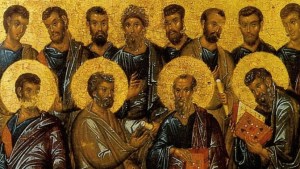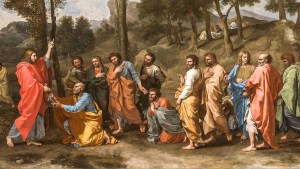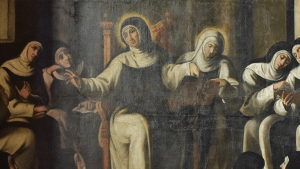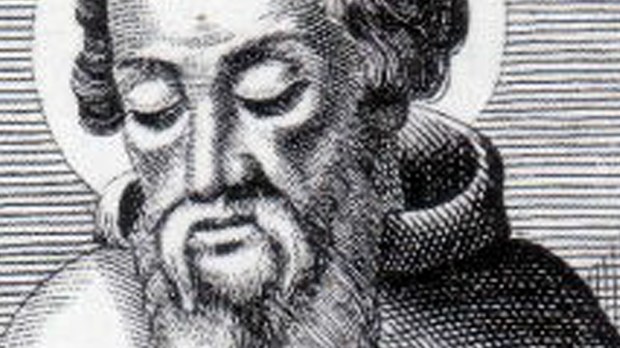I love a good police procedural show. I love the stock characters that always appear: the gruff veteran detective, the geeky lab tech, and the street-wise young cop. I love the little bits that provide authenticity, like when they recite the Miranda warning to suspects (“You have the right to remain silent,” etc.), or when you see them bagging evidence and then signing it to preserve chain of custody.
Naturally, this last part makes me think of St. Irenaeus of Lyons.
Maybe that connection isn’t immediately evident. Let me explain.
St. Irenaeus, the bishop of Lyons who died in 202, is best remembered for his masterwork Against Heresies (also known as Against the Knowledge Falsely So-called), in which he responds in detail to the claims of various heretical groups, particularly the Gnostics.
Now, “Gnostic” is kind of a catch-all term for a variety of groups with differing beliefs, but they shared in common the idea that there was “secret knowledge” (or gnosis) that provided a wider revelation than that found in the nascent New Testament. This included content like the existence of multiple gods, the evil of the material world that is a trap for pure souls, and additional stories about Jesus (such as a child Jesus bringing clay birds to life), and was contained in texts like the spurious Gospel of Judas or the Second Treatise of the Great Seth.

Read more:
What did Christianity look like before the Bible?
How was a Christian to know what to believe? Why should they accept the Gospel of Luke but reject the Gospel of Mary Magdalene? Why not read the Letter to Flora rather than the Letter to Philemon?
St. Irenaeus had an answer to this. He responded that we could know which teachings were true and which texts were authentic by looking at who was promoting them. If the purveyor was a self-appointed leader, a Johannes-come-lately whose ideas weren’t any older than himself and whose text still had wet ink, the odds are the ideas were less than trustworthy. However, if a teacher is a bishop in a clear line of succession from bishops who trace themselves to the apostles, you can be assured that the teaching is sound.
St. Irenaeus elaborates on this in Book Three, Chapter Three of Against Heresies. He argues that if Jesus had brought hidden knowledge as the Gnostics claim, surely He would have passed it on to His apostles, and surely they would have handed it on to their successors, the bishops. But since we know the whole line of bishops that can trace their authority back to the apostles, and we can see that none of them teach as the Gnostics do, we can be assured that the Gnostics are in error.
(As an interesting side note: St. Irenaeus uses as his example of succession the church of Rome, “for it is a matter of necessity that every Church should agree with this Church, on account of its preeminent authority.”)
This is where the “chain of custody” comparison comes in. When law enforcement officials handle evidence, they have to keep a record of having handled the item. That way, if a piece of evidence is lost, officials will know who was the last to see it. And if some question arises about the authenticity of the evidence—whether perhaps it was planted, or replaced with another item—the written record provides a series of links, a “chain of custody,” ensuring that the evidence is legitimate.
Likewise, the bishops themselves, having received their office by the imposition of hands (and, in ancient cases, receiving their intellectual and spiritual formation as well) from those who trace their authority in a direct line back to the apostles, stand as living links in a chain trailing back into the centuries, all the way to Peter and Paul, and to Jesus Himself. Jesus commissioned His apostles to spread the Gospel and baptize all nations, as seen in Matthew 28; and as St. Paul’s letters to Timothy and Titus show us, Jesus’ apostles appointed others to carry on that mandate as well, spreading the message of Jesus and the grace of the sacraments across time and space. The bishops exercise this ministry authoritatively.

Read more:
Whatever happened to the Twelve Apostles?
Of course, we should not have the impression that every individual bishop is assured to always and everywhere teach without error. There is no gift of “episcopal infallibility.” Not at the individual level, anyway. The Church does teach that the whole college of bishops teaches infallibly when all the bishops of the world agree on the truth of matters concerning faith and morals (see Lumen Gentium 25).
And this is fitting, given our analogy. It is the strength of all the links together that makes the chain strong. So think of St. Irenaeus next time you watch CSI!

Read more:
5 Sayings from the Desert Mothers on how to deal with adversity

